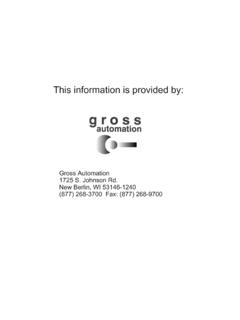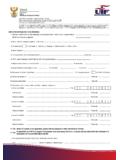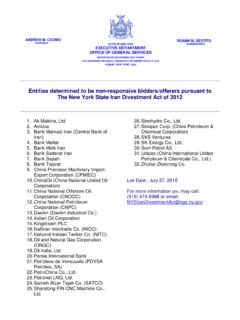Transcription of Guideline on process validation for finished …
1 30 Churchill Place Canary Wharf London E14 5EU United Kingdom An agency of the European Union Telephone +44 (0)20 3660 6000 Facsimile +44 (0)20 3660 5555 Send a question via our website European Medicines Agency, 2016. Reproduction is authorised provided the source is acknowledged. 21 November 2016 EMA/CHMP/CVMP/QWP/BWP/70278/2012-Rev1, Committee for Medicinal Products for Human Use (CHMP) Committee for Medicinal Products for Veterinary Use (CVMP) Guideline on process validation for finished products - information and data to be provided in regulatory submissions Draft agreed by CHMP / CVMP Quality Working Party 2 February 2012 Adoption by CVMP for release for consultation 8 March 2012 Adoption by CHMP for release for consultation 15 March 2012 End of consultation (deadline for comments) 31 October 2012 Agreed by QWP 8 November 2013 Agreed by BWP 13 November 2013 Adoption by CHMP 19 December 2013 Adoption by CVMP 15 January 2014 Date for coming into effect 6 months after publication Minor update* 21 September 2016 Agreed by QWP and IWG 21 September 2016 Agreed by BWP 5 October 2016 Adoption by CHMP 10 November 2016 Adoption by CVMP 10 November 2016 Guideline on process validation for finished products - information and data to be provided in regulatory submissions EMA/CHMP/CVMP/QWP/749073/2016 Page 2/15 This Guideline replaces the note for guidance on process validation (CPMP/QWP/848/96, EMEA/CVMP/598/99) including annex II non-standard processes (CPMP/QWP/2054/03).
2 *This is an update to the definition for on-line measurement included in the glossary and it is not intended as a full revision of this Guideline . This change is considered to be minor and uncontroversial and consequently a consultation phase was considered to be unnecessary. Keywords process validation , continuous process verification, on-going process verification, critical process parameter, critical quality attribute, lifecycle, change control Guideline on process validation for finished products - information and data to be provided in regulatory submissions EMA/CHMP/CVMP/QWP/749073/2016 Page 3/15 Table of contents Executive summary .. 4 1. Introduction (background) .. 4 2. 4 3. Legal basis .. 5 4. General considerations .. 5 5. process validation .. 5 Traditional process validation .. 5 Continuous process verification .. 6 Hybrid approach .. 7 Design space verification .. 8 6.
3 Scale-up .. 8 7. Post approval change control .. 8 8. Standard vs. non-standard methods of manufacture .. 9 Definitions .. 9 References .. 11 Annex I: process validation scheme .. 12 Annex II: Standard/non-standard processes .. 14 Guideline on process validation for finished products - information and data to be provided in regulatory submissions EMA/CHMP/CVMP/QWP/749073/2016 Page 4/15 Executive summary This Guideline replaces the previous note for guidance on process validation (CPMP/QWP/848/96, EMEA/CVMP/598/99). The Guideline is brought into line with ICH Q8, Q9 and Q10 documents and the possibility to use continuous process verification in addition to, or instead of, traditional process validation described in the previous Guideline has been added and is encouraged. This Guideline does not introduce new requirements on medicinal products already authorised and on the market, but clarifies how companies can take advantage of the new possibilities given when applying enhanced process understanding coupled with risk management tools under an efficient quality system as described by ICH Q8, Q9 and Q10.
4 1. Introduction (background) process validation can be defined as documented evidence that the process , operated within established parameters, can perform effectively and reproducibly to produce a medicinal product meeting its predetermined specifications and quality attributes (ICH Q7). Continuous process verification has been introduced to cover an alternative approach to process validation based on a continuous monitoring of manufacturing performance. This approach is based on the knowledge from product and process development studies and / or previous manufacturing experience. Continuous process verification may be applicable to both a traditional and enhanced approach to pharmaceutical development. It may use extensive in-line, on-line or at-line monitoring and / or controls to evaluate process performance. It is intended that the combination of the advice provided in the Note for Guidance on Development Pharmaceutics (CPMP/QWP/155/96) and the Note for Guidance on Pharmaceutical Development (ICH Q8R2) together with this Guideline should cover all of the critical elements in manufacturing process for inclusion in the dossier for regulatory submission for a pharmaceutical product for human use.
5 For veterinary medicinal products, the applicable guidance is that provided in the Note for Guidance on Development Pharmaceutics for Veterinary Medicinal Products (EMEA/CVMP/315/98) together with this Guideline . Although the ICH Q8 Guideline is not applicable to veterinary medicinal products the principles detailed in this Guideline may be applied to veterinary medicinal products should an applicant choose to apply an enhanced approach to pharmaceutical development and process validation . process validation should not be viewed as a one-off event. process validation incorporates a lifecycle approach linking product and process development, validation of the commercial manufacturing process and maintenance of the process in a state of control during routine commercial production. 2. Scope This document is intended to provide guidance on the process validation information and data to be provided in regulatory submissions for the finished dosage forms of chemical medicinal products for human and veterinary use.
6 The general principles also apply to active substances. However, information on validation of non-sterile active substances is not required in the dossier. In addition, expectations for active substances are contained in ICH Q11 and so the information is not repeated in this document. The principles described are also applicable to biological medicinal products. However, these should be considered on a case by case basis in view of the complex nature and inherent variability of the biological substance. Guideline on process validation for finished products - information and data to be provided in regulatory submissions EMA/CHMP/CVMP/QWP/749073/2016 Page 5/15 It is expected that the information / data requested in this Guideline be present in the dossier at the time of regulatory submission. This document provides guidance on the validation of the manufacturing process , which can be considered as the second stage in the product lifecycle.
7 The first stage ( process design) is covered in the note for guidance on pharmaceutical development (ICH Q8R2/ EMEA/CVMP/315/98) and the third stage (on-going process verification) is covered under GMP (Annex 15). 3. Legal basis This Guideline has to be read in conjunction with the introduction and general principles section (4) of Annex I to Directive 2001/83/EC as amended and the introduction and general principles section (2) of Annex I to Directive 2001/82/EC as amended. 4. General considerations Irrespective of whether a medicinal product is developed by a traditional approach or an enhanced approach, the manufacturing process should be validated before the product is placed on the market. In exceptional circumstances concurrent validation may be accepted. Please refer to GMP Annex 15 for further guidance. process validation should confirm that the control strategy is adequate to the process design and the quality of the product.
8 The validation should cover all manufactured strengths and all manufacturing sites used for production of the marketed product. A bracketing approach may be acceptable for different strengths, batch sizes and pack sizes. However, validation must cover all proposed sites. process validation data should be generated for all products to demonstrate the adequacy of the manufacturing process at each site of manufacture. validation should be carried out in accordance with GMP and data should be held at the manufacturing location and made available for inspection if not required in the dossier (see section 8). process validation can be performed in a traditional way, as described below, regardless of the approach to development taken. However, there is also the possibility to implement continuous process verification if an enhanced approach to development has been performed or where a substantial amount of product and process knowledge and understanding has been gained through historical data and manufacturing experience.
9 A combination of traditional process validation and continuous process verification may be employed. The in-line, on-line or at-line monitoring that is often utilised for continuous process verification (discussed in section ) provides substantially more information and knowledge about the process and might facilitate process improvements. 5. process validation Traditional process validation Traditional process validation is normally performed when the pharmaceutical development and/or process development is concluded, after scale-up to production scale and prior to marketing of the finished product. As part of the process validation lifecycle, some process validation studies may be conducted on pilot scale batches if the process has not yet been scaled up to production scale. It should be noted that pilot batch size should correspond to at least 10% of the production scale batch ( such that the multiplication factor for the scale-up does not exceed 10).
10 For solid oral dosage Guideline on process validation for finished products - information and data to be provided in regulatory submissions EMA/CHMP/CVMP/QWP/749073/2016 Page 6/15 forms this size should generally be 10% of the maximum production scale or 100,000 units whichever is the greater1. Where the intended batch size is less than 100,000 units, the predictive value of the pilot batches may be limited and a justified approach should be followed. For other dosage forms the pilot batch size should be justified taking into account risk to the patient of failure of the dosage form. Since it is not generally considered useful to conduct full validation studies on pilot scale batches, the process validation scheme outlined in Annex I of this Guideline should be completed for each product for subsequent execution at production scale; bracketing may be acceptable. The process validation scheme to be followed should be included in the dossier.
















